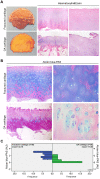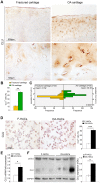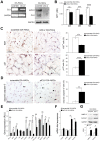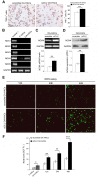Clusterin exerts a cytoprotective and antioxidant effect in human osteoarthritic cartilage
- PMID: 32516132
- PMCID: PMC7346069
- DOI: 10.18632/aging.103310
Clusterin exerts a cytoprotective and antioxidant effect in human osteoarthritic cartilage
Abstract
Osteoarthritis (OA) is the most common joint disease characterized by destruction of articular cartilage. OA-induced cartilage degeneration causes inflammation, oxidative stress and the hypertrophic shift of quiescent chondrocytes. Clusterin (CLU) is a ubiquitous glycoprotein implicated in many cellular processes and its upregulation has been recently reported in OA cartilage. However, the specific role of CLU in OA cartilage injury has not been investigated yet. We analyzed CLU expression in human articular cartilage in vivo and in cartilage-derived chondrocytes in vitro. CLU knockdown in OA chondrocytes was also performed and its effect on proliferation, hypertrophic phenotype, apoptosis, inflammation and oxidative stress was investigated. CLU expression was upregulated in human OA cartilage and in cultured OA cartilage-derived chondrocytes compared with control group. CLU knockdown reduced cell proliferation and increased hypertrophic phenotype as well as apoptotic death. CLU-silenced OA chondrocytes showed higher MMP13 and COL10A1 as well as greater TNF-α, Nox4 and ROS levels. Our results indicate a possible cytoprotective role of CLU in OA chondrocytes promoting cell survival by its anti-apoptotic, anti-inflammatory and antioxidant properties and counteracting the hypertrophic phenotypic shift. Further studies are needed to deepen the role of CLU in order to identify a new potential therapeutic target for OA.
Keywords: cartilage; clusterin; osteoarthritis; oxidative stress; survival.
Conflict of interest statement
Figures






References
-
- Hinton R, Moody RL, Davis AW, Thomas SF. Osteoarthritis: diagnosis and therapeutic considerations. Am Fam Physician. 2002; 65:841–48. - PubMed
Publication types
MeSH terms
Substances
LinkOut - more resources
Full Text Sources
Research Materials
Miscellaneous

